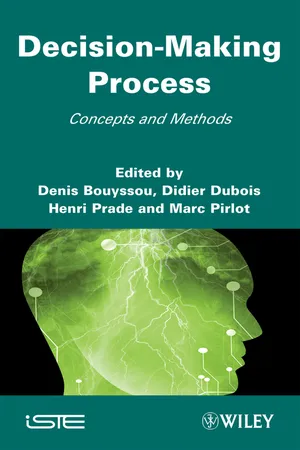Economics
Risk Aversion
Risk aversion refers to the tendency of individuals to prefer certainty over uncertainty when making decisions involving risk. In economic terms, it means that people are willing to accept a lower expected return in exchange for a reduction in the variability of that return. This behavior is a key concept in understanding decision-making under uncertainty.
Written by Perlego with AI-assistance
Related key terms
4 Key excerpts on "Risk Aversion"
- eBook - ePub
- Louis Eeckhoudt, Christian Gollier, Harris Schlesinger(Authors)
- 2011(Publication Date)
- Princeton University Press(Publisher)
Part I Decision Theory 1 Risk Aversion This chapter looks at a basic concept behind modeling individual preferences in the face of risk. As with any social science, we of course are fallible and susceptible to second-guessing in our theories. It is nearly impossible to model many natural human tendencies such as “playing a hunch” or “being superstitious.” However, we can develop a systematic way to view choices made under uncertainty. Hopefully, our models can capture the basic human tendencies enough to be useful in understanding market behavior towards risk. In other words, even if we are not correct in predicting behavior under risk for every individual in every circumstance, we can still make general claims about such behavior and can still make market predictions, which after all are based on the “marginal consumer.” To use (vaguely) mathematical language, the understanding of this chapter is a necessary but not sufficient condition to go further into the analysis. Because of the importance of Risk Aversion in decision making under uncertainty, it is worthwhile to first take an “historical” perspective about its development and to indicate how economists and decision scientists progressively have elaborated upon the tools and concepts we now use to analyze risky choices. In addition, this “history” has some surprising aspects that are interesting in themselves. To this end, our first section in this chapter broadly covers these retrospective topics - eBook - ePub
- Nicholas L. Georgakopoulos(Author)
- 2018(Publication Date)
- Palgrave Macmillan(Publisher)
© The Author(s) 2018 Nicholas L. Georgakopoulos Illustrating Finance Policy with Mathematica Quantitative Perspectives on Behavioral Economics and Finance https://doi.org/10.1007/978-3-319-95372-4_10Begin Abstract10. Aversion to Risk
End AbstractNicholas L. Georgakopoulos1(1) Indiana University, Indianapolis, IN, USA1 Risk Aversion
Attitudes toward risk are central to the choices people make. Therefore, attitudes toward risk are important for the incentive scheme that law and policy produce as well as for the assessment of values that finance studies. In this chapter, we enter the mathematical understanding of aversion to risk when it applies to money. Attitudes toward risk outside monetary choices are still not well understood. Also, attitudes toward risk about money do not seem closely related to those about unrelated activities. We see little paradoxical about a solo ice-climber, for example, who would pay for a mistake half-way up a frozen waterfall with the ice-climber’s own life, in taking no financial risk and only investing in treasuries. Vice versa, a venture capitalist, most of whose investments are destined to fail, would not be seen as strange if the venture capitalist takes very few physical risks, driving exceedingly cautiously and exercising only in the safest ways. Aversion to physical risk has little relation to aversion to financial risk, and our economic models only deal with financial risk. From here, risk refers only to financial risk.The road to comprehending risk begins at simple gambles. Someone faces a choice between receiving a certain amount and two risky amounts. For example, the risky amounts may be $100 and $900, say, depending on the toss of a coin. If the coin comes heads, take $900, if tails then $100. The uncertainty, thus, is the $100 or $900 outcome. This example will be the foundation for understanding reactions to risk. The first step is to recognize the subjectivity of the correspondence between the risk and a certain amount. - eBook - ePub
RISK21 - Coping with Risks due to Natural Hazards in the 21st Century
Proceedings of the RISK21 Workshop, Monte Verità, Ascona, Switzerland, 28 November - 3 December 2004
- Walter J. Ammann, Stefanie Dannenmann, Laurent Vulliet(Authors)
- 2006(Publication Date)
- CRC Press(Publisher)
Figure 6 shows a wide collection of propositions for Risk Aversion functions. For none of them exists a profound explanation of the underlying reasoning. The functions have usually been defined in a consensus finding process. It is quite obvious that a generally accepted solution for handling Risk Aversion is still lacking.Figure 6. Different propositions of functions for a Risk Aversion factor.5 INTEGRATION OF Risk Aversion IN SOCIETAL DECISION-MAKING
What has been said here about Risk Aversion gives of course just a rough idea of the problem. It shows that Risk Aversion is a relevant issue and gives some idea of what kind of aspects should be looked at. But apart from further research for a better understanding of Risk Aversion some deeper thoughts should be devoted to the integration of such issues in our societal decision-making process, Risk Aversion being of course just one effect which influences risk assessment.5.1 Understanding the societal decision-making mechanisms and processes in risk assessment
The first example of a simple lottery ticket concerned a single and personal decision. Now lets imagine that somebody has to make such decisions frequently and that he is not in a position to do it by himself. So he may hire a person, we could call it an agent, who takes the decisions for him. Of course he would have to give his agent some instructions or rules how to decide in his name.This is exactly the situation of a society and its representatives on a professional level as well as on a political level. So all the efforts to develop methods and models for risk assessment have as a central goal the definition of decision procedures and rules for the “agents” of the society because the society cannot decide itself on a case by case basis. And we certainly expect from these rules and procedures that they lead to decisions which are consistent with the value system of the society and that they are consistent amongst each other. The idea of the lottery ticket may contribute to get a feeling for the basic mechanism behind such decisions in risk situations. - eBook - ePub
Decision Making Process
Concepts and Methods
- Denis Bouyssou, Didier Dubois, Henri Prade, Marc Pirlot(Authors)
- 2013(Publication Date)
- Wiley-ISTE(Publisher)
X .We can define various notions of Risk Aversion. We will focus on two of them in this chapter.Definition 8.4. An agent is weakly risk averse if, for any random variable X in , the expected value is preferred to the random variable itself [ARR 65, PRA 64]:They are weakly risk seeking ifThey are risk neutral ifThis definition is usually not strong enough to rank two distributions with the same mean. One can also use another definition as follows.Definition 8.5. A decision maker is strongly risk averse if for any two random variables X , Y in with the same expected value, such that Y is more risky than X according to second-order stochastic dominance, the less risky variable X is preferred to Y :They are strongly risk seeking ifThey are risk neutral ifIf a decision maker does not always rank a couple of random variables (Y MPS X ) in the same way, they will not fit into any of these categories.Remark 8.4. It is easy to see that for all X , X MPS E (X ). Hence, a strongly risk averse decision maker will necessarily be weakly risk averse. The converse does not hold in general.8.2.2.2. Certainty equivalent, risk premium and behavior comparison8.2.2.2.1. Certainty equivalent
For each random variable X in , its certainty equivalent , if it exists, is the certain outcomecXin that is indifferent to X :cXX . In this chapter, any random variable in has a unique certainty equivalent.8.2.2.2.2. Risk premium
The risk premium attached to X is denotedρX. It is the difference between the expected value of X and its certainty equivalent:ρX= E (X ) −cX.This premium can be interpreted as the maximum amount the decision maker is willing to pay to exchange the variable X with its mean. This premium is negative whenever the decision maker is weakly risk seeking.The risk premium captures the intensity of (weak) aversion to risk. It is possible to use it to compare, in a partial manner, different behaviors.
Learn about this page
Index pages curate the most relevant extracts from our library of academic textbooks. They’ve been created using an in-house natural language model (NLM), each adding context and meaning to key research topics.



